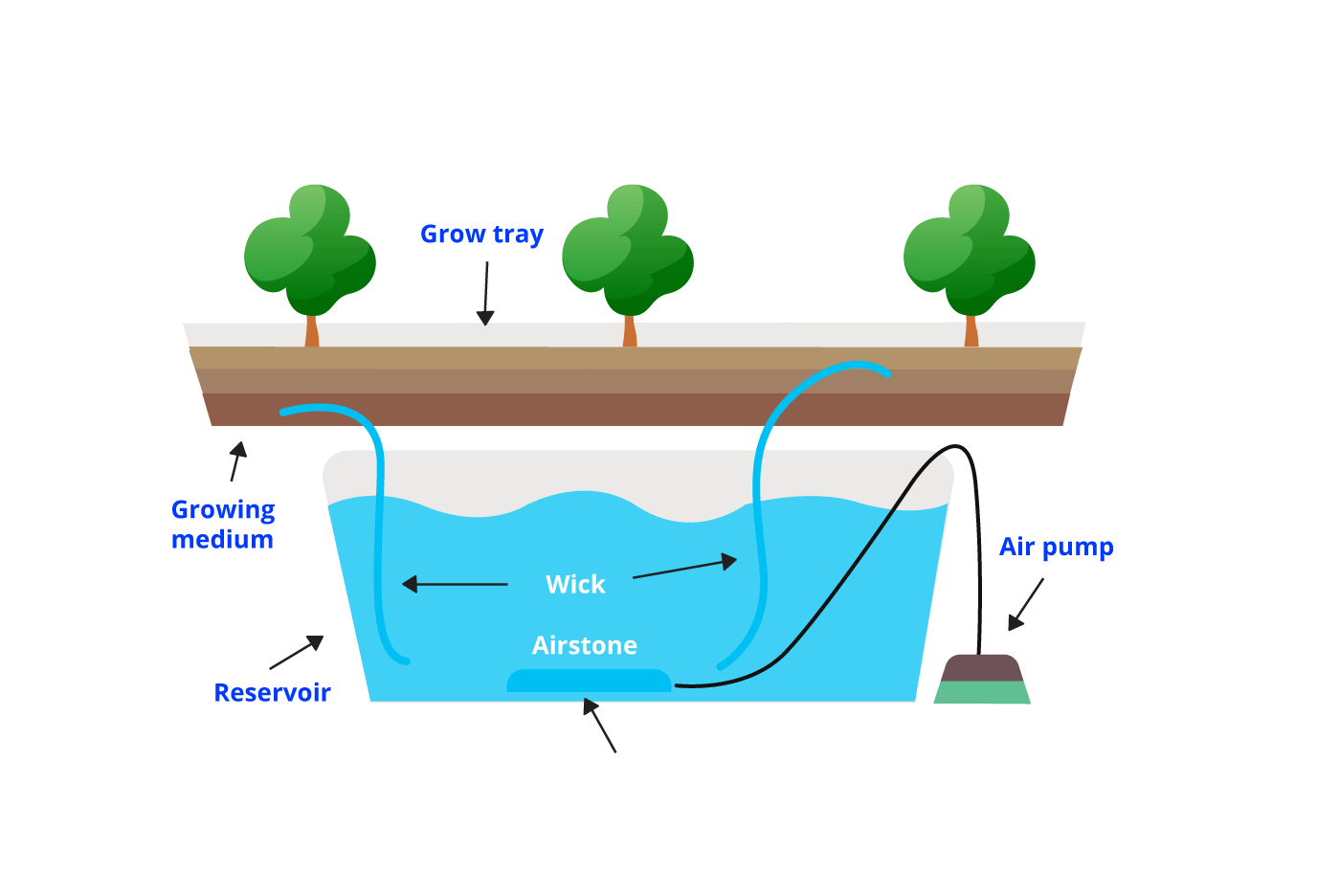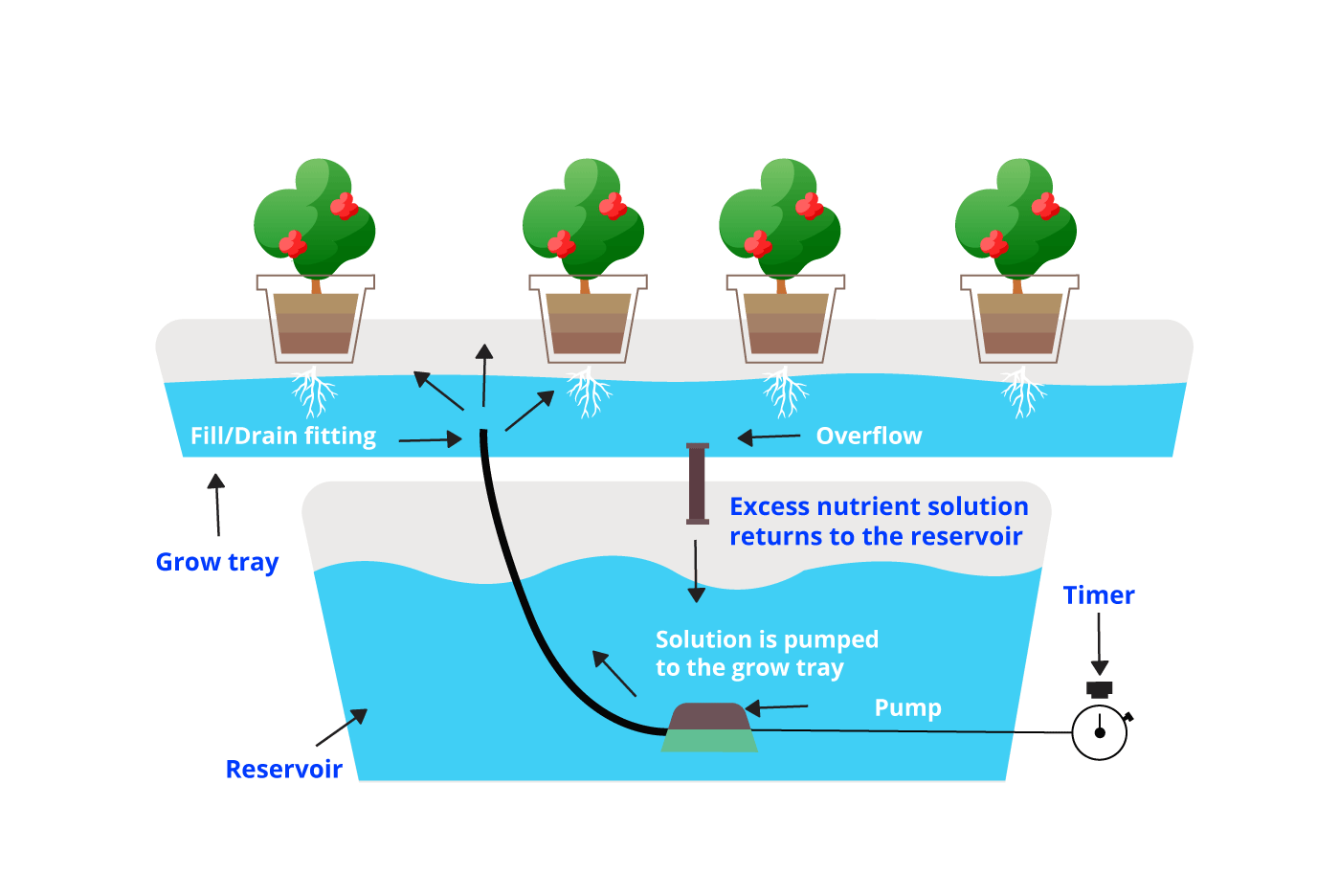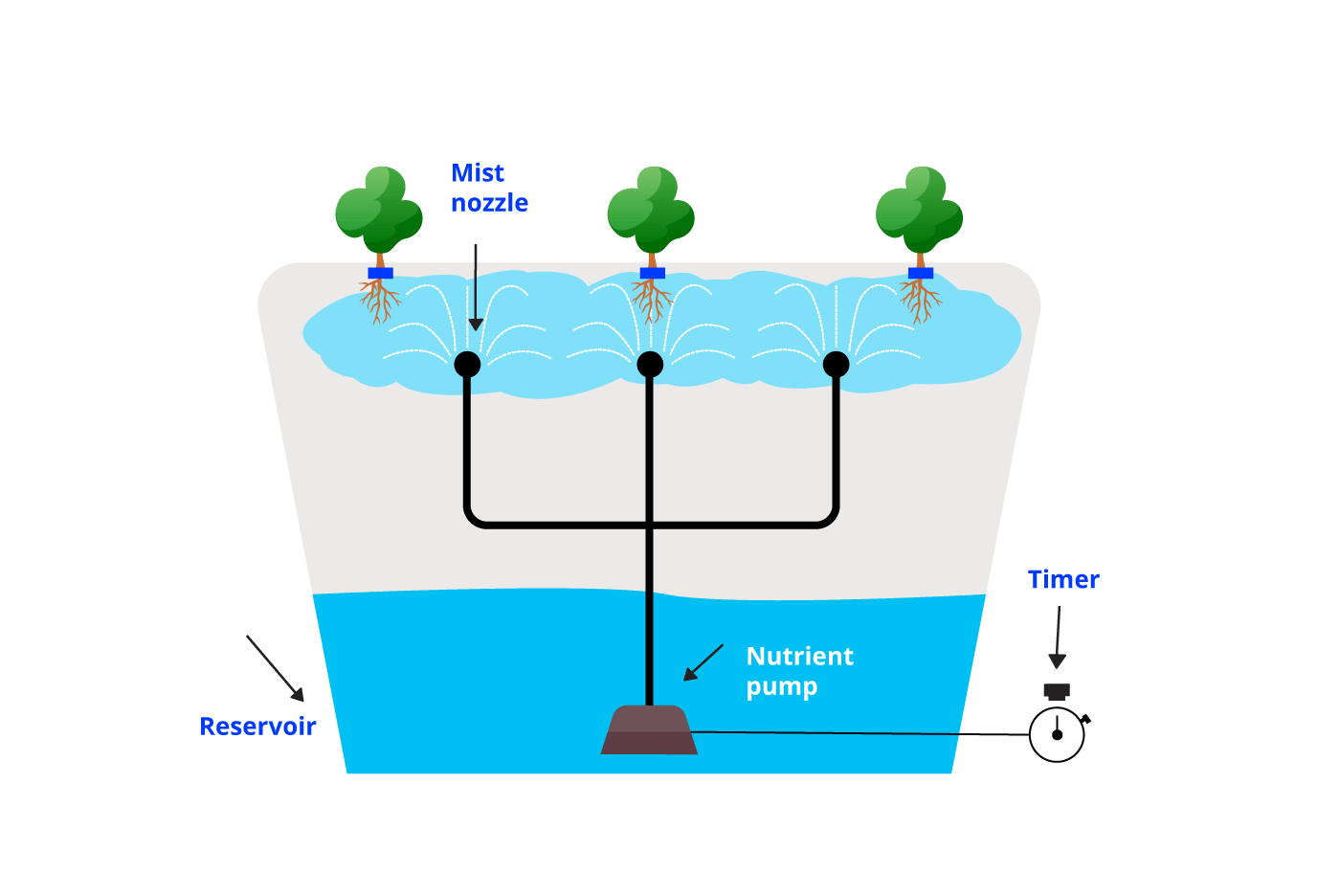
Kasha Dubaniewicz
Kasha is passionate about high-impact storytelling and believes in making positive changes that will lead to a better and happier world for all.
What is hydroponics?
Hydroponics is a growing method that makes use of a solution of nutrients and water as opposed to soil. Hydroponic systems can vary widely in scale, from a small apartment-based setup to a full hydroponic greenhouse.
Not only can this growing method vary in terms of scale, there are also a number of different setups you can use to grow hydroponically. In this post, we'll look at the most common hydroponic setups, as well as some of the pros and cons you should consider before growing your plants this way.
Hydroponic growing: The pros
Although hydroponic setups may look a little complicated at first glance, there are a number of big positives when it comes to choosing this growing method. Here are some of the biggest benefits of hydroponic growing:
- Often cited as the biggest pro of hydroponics, this growing method drastically reduces the amount of water needed to grow plants. In fact, it's believed that hydroponics can use up to 95% less water than traditional open-field agriculture. Not only will this help you save water at your own grow site, but this growing method has already been revolutionising crop growing in water-scarce parts of the world.
- You can grow anywhere! Since you're not restricted by the need to have access to fertile ground, this means that you can set up your hydroponic system in any space. In addition, it's thought that hydroponics requires 20% less space on average compared with other growing methods.
- Likewise, you can grow plants throughout the year, which means that you won't be restricted by crop seasonality. For food supply chains around the world, this type of growing helps to reduce the risk of food shortages.
- When you closely monitor and optimise parameters like temperature, pH and nutrients in a hydroponic setup, not only will you be able to grow faster, but you'll also be able to directly influence crop yield and quality.
- While the initial setup may require a fair bit of work, you can reduce labour requirements overall when you grow hydroponically, as you're cutting out the need for time-intensive processes like tilling and mulching.
- You'll have better nutrient management in a hydroponic system, as you'll have total control over how much nutrient you're providing to your plants at any given time. Many hydroponic systems also recirculate their water, which means that your nutrients will keep working their way through the system until they're used up, which helps to reduce nutrient wastage.
- Your hydroponic setup will be a controlled environment, which means that there'll be less need for pesticides and other chemicals. These chemicals are known to have a detrimental effect on the environment.
Hydroponic growing: the cons
While we believe that the benefits of hydroponic growing far outweigh the negatives, it's good to be aware of the challenges associated with this method:
- When mistakes or big fluctuations happen, these affect your plants faster since there is no soil, which acts as a natural buffer.
- The initial setup of an advanced hydroponic system can be quite costly and time consuming. This is partly due to the fact that this type of growing can be heavily dependent on technology. This is especially seen in commercial-scale hydroponic farms, where the plants' environment is completely controlled, which means that the site will need to be kitted out with meters, monitors and controllers that will spot and fix any fluctuations that come up.
- Depending on the type of setup you have, your system can be affected by power outages.
- You need to pay attention to your water quality and keep an eye on waterborne diseases, which can take hold quickly in a hydroponic system. To avoid this, it's recommended to carry out regular cleaning.
Common hydroponic systems
There are a number of different hydroponic systems to consider, depending on how many plants you want to grow, which type of plant as well as whether you're looking for an active or passive system.
An active hydroponic system will be moving the nutrient solution to the plants, usually through the use of a pump. A passive system, on the other hand, relies on a wick or the anchor of the growing media.
Below, we'll take a look at six of the most common types of hydroponic systems.
Please note: if your plants do not have access to natural light, you will need to incorporate artificial lighting into your setup.
The Wick System

Due to its easy setup, the Wick System is considered to be a good option for beginners, as this system contains no moving parts or electrical components. Instead, the Wick System is passive, where the nutrient solution makes its way to the plants from the reservoir to the growing tray using capillary force via the wicks. Some growers choose to add an air pump to their setup, which aerates the water and reduces the risk of algae build-up.
In this system, you'll have a bucket or basin as your reservoir, which is topped with your growing tray; perlite, coco coir, vermiculite and soilless mixes are often used as the growing medium here. Connect the reservoir with the bottom of the growing tray with one or two wicks.
What types of plants can you grow?
The Wick System works best for microgreens, herbs and peppers; it can't be used for water-hungry plants or larger, fruiting crops like tomatoes.
Take a look at this great guide to the Wick System and find out how you can go about setting one up for yourself.
Deep Water Culture (DWC) System

This is another good option for beginners. The Deep Water Culture (DWC) System works by suspending plants in net pots so that only their root systems are submerged; this ensures that they have direct, 24/7 access to the nutrient-rich and oxygenated solution of your reservoir. The net pots are held up by a platform, usually made of styrofoam.
An air pump is essential, as you'll need to aerate the water in your reservoir to help the roots 'breathe'. That makes a DWC System active, since your water and nutrients are recirculating in this setup.
Setup is fairly simple; you'll need a bucket or basin for your reservoir and your netted pots will contain a growing medium like coco coir, perlite, vermiculite, rock wool or clay balls.
What types of plants can you grow?
The DWC System is good for water-hungry plants like lettuce, leafy greens and herbs, but not for plants that have a longer growing cycle.
Check out this definitive guide to DWC to find out how to set up your own system for the first time.
Ebb and Flow System

The Ebb and Flow System, also known as Flood and Drain, is a setup that's suitable for intermediate growers. While this system may initially look a little complex, an Ebb and Flow System is straightforward in its mechanics.
At particular intervals, this system 'floods' its grow tray with nutrient solution from the reservoir - this can be automated by connecting your pump to a timer.
The grow tray is positioned above your reservoir, connected by both a fill tube and a drain tube. The timer will determine when the fill tube draws up nutrient solution into the grow tray. Once this has had time to fully surround your plants' root zone, the solution will drain back into the reservoir via the drain tube. You would use a growing medium like rock wool, perlite, vermiculite or gravel in this system.
This active system is vulnerable to disruptions caused by power outages or timer failure, which could cause the roots to dry out.
What types of plants can you grow?
The Ebb and Flow System is ideal for water-hungry crops, such as lettuce, spinach, other leafy greens and tomatoes.
To find out more about this system, read this Ebb and Flow guide.
Nutrient Film Technique (NFT)

The Nutrient Film Technique (NFT) is a more advanced active system, where the nutrient solution is constantly flowing in a thin 'film' through the bottom of your plants' root zone. The upper part of the root system is exposed to air to ensure that it has access to oxygen.
The solution is consistently pumped up into the inclined growing tray, which means that you don't need a timer, and once it reaches the end of the tray, this gradually returns to the reservoir via a drainage tube.
In the NFT System, no growing medium required. Instead, your plants are suspended in grow baskets or another type of support structure.
Because the nutrient solution is recirculating, the NFT System helps to reduce both nutrient and water waste.
However, since there is no growing medium to help retain moisture, your plant roots can dry out if there is a power outage or pump failure.
What types of plants can you grow?
The NFT System is most effective for small, fast-growing plants like leafy greens and herbs. It isn't ideal for larger or fruit-bearing plants.
Thinking of giving this setup a go? Take a look at this NFT how-to guide to get started.
The Drip System

The Drip System is another active setup that's more suitable for intermediate and advanced hydroponic growers, where nutrient solution is slowly pumped to your plants via a network of drip lines. This system is very popular and is commonly used in commercial-scale hydroponic farms. It's also used for vertical farming.
The nutrient solution makes its way through the drip lines, which is facilitated by a pump and timer; this system gives the grower a lot of control with regards to nutrient and water management.
Your grow tray should be filled with a slow-draining medium, such as rock wool, peat moss or coco coir. For utmost efficiency, the Drip System can have a recovery setup, whereby the leftover nutrient solution can drain back into the reservoir. In this mode, you need to pay careful attention to pH and EC/PPM fluctuations.
In addition, the drip emitters in this system are prone to clogging due to nutrient build-up or algae; however, there are various solutions for managing this potential issue.
What types of plants can you grow?
The Drip System is versatile and can be used to support the growth of a wide variety of plants, including larger plants that usually can't be grown with other hydroponic systems.
Ready to start your own Drip System? Read this Drip System guide to find out more.
The Aeroponic System

The Aeroponic System is an active system that's suitable for advanced growers. It's also one of the more expensive and complex options in terms of setup. In this system, plants are suspended - usually in net pots - while their roots are continuously misted with nutrient solution through the use of a pump and timer.
This growing system makes little or no use of growing media; instead, the roots are consistently kept moist while also having direct access to oxygen. In addition, since the reservoir is located beneath your plants, the excess solution drips down so that it can be recirculated through the system.
You'll need a little trial and error to find the perfect misting frequency, angle of misting and pressure for your plants, but that also makes this system quite versatile and customisable.
While this is considered to be a nutrient- and water-efficient system, your plant roots can be at risk of drying out if there is a power outage or pump value due to the lack of growing media.
What types of plants can you grow?
The Aeroponic System can be used to grow smaller plants like leafy greens and herbs.
Take a look at this ultimate guide to the Aeroponic System to decide whether this is the right setup for you.
Recommended products for your hydroponic system
Regardless of which hydroponic setup you end up choosing, you'll need to closely monitor your key plant health fundamentals in order to achieve better crop yield.
These fundamentals include potential Hydrogen (pH) and Electrical Conductivity (EC) and temperature. You should also pay close attention to your environmental factors, such as lighting, water quality and air circulation.
For a consistently successful hydroponic system, here are our recommended products to get you started on your hydroponics journey:
- Bluelab pH Pen: An affordable, portable and robust pen that will measure the pH and temperature of your nutrient solution.
- Bluelab Conductivity Pen: This compact and robust pen will help you measure the conductivity and temperature of your nutrient solution on the go.
- Bluelab Truncheon Nutrient Meter: One of our most beloved products, this impossibly tough EC meter has been built to last a lifetime.
- Bluelab Combo Meter: Measure the pH, EC and temperature of your reservoir with this compact multi-parameter meter.
- Bluelab Combo Meter Plus: Paired with the ultra-fast Leap Probe, this multi-parameter meter measures pH, EC and temperature in nutrient solutions and any substrate.
If you're looking to upgrade your hydroponic system, take a look at our range of monitors and controllers, which will automatically manage your plant health parameters.
Have you tried out any of these hydroponic setups or their variations? Let us know about your experience in the comments below.




Submit a comment